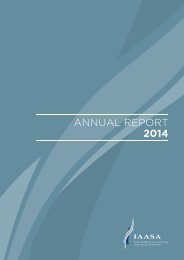Annual_Report2014
You also want an ePaper? Increase the reach of your titles
YUMPU automatically turns print PDFs into web optimized ePapers that Google loves.
<strong>Annual</strong> Report 2014<br />
Irish Auditing & Accounting Supervisory Authority<br />
56<br />
benefits relating to employee service in the current<br />
and prior periods. Thus, the amount of the postemployment<br />
benefits received by the employee is<br />
determined by the amount of contributions paid<br />
by an entity (and perhaps also the employee) to<br />
a post-employment benefit plan or to an insurer,<br />
together with investment returns arising from<br />
the contributions”. All other schemes are to be<br />
treated as Defined Benefit schemes.<br />
In substance, the directors consider that the<br />
obligation to pay retirement benefits remains with<br />
IAASA, but that the Exchequer has committed<br />
to providing IAASA with sufficient funds to settle<br />
any such obligations on IAASA’s behalf as they<br />
fall due, provided IAASA pays over employees’<br />
and the employer’s contributions at rates<br />
specified by the Minister for Public Expenditure &<br />
Reform. Notwithstanding that the Exchequer has<br />
confirmed that it will bear all liabilities arising to<br />
IAASA employees (and their spouses, civil partners<br />
and children) in return for a fixed contribution, the<br />
Directors remain of the view that the contractual<br />
obligation remains between the Authority and its<br />
employees. Consequently, the directors continue<br />
to account for the schemes as Defined Benefit<br />
schemes. Accordingly, the financial statements<br />
recognise both a Retirement Benefit Obligation<br />
and a Deferred Exchequer Retirement Benefit<br />
Funding receivable.<br />
3.4 Inventory<br />
Stocks on hand at period end represent stocks of<br />
information technology consumables and office<br />
consumables and are stated at the lower of cost<br />
and net realisable value.<br />
3.5 Revenue<br />
In accordance with section 921(1) of the 2014<br />
Act, any excess of income over expenditure in<br />
any financial period shall be applied towards<br />
meeting IAASA’s Programme of Expenditure in<br />
the following period and any amounts payable<br />
from the Exchequer and PABs respectively shall<br />
be appropriately reduced. Section 921(2) provides<br />
that income set aside for Reserve Fund purposes<br />
is not considered to be income for this purpose.<br />
The treatment of income set aside for Reserve<br />
Fund purposes is detailed further below.<br />
3.5.1 Exchequer grant income via the<br />
Department<br />
Section 914(2) of the 2014 Act provides that a<br />
grant not exceeding 40% of IAASA’s approved<br />
Programme of Expenditure for the period shall,<br />
subject to any conditions thought proper by<br />
the Minister, be paid to IAASA out of monies<br />
provided by the Oireachtas. The Department<br />
has stipulated that the grant that will be paid<br />
in any given financial period will be such as<br />
to meet 40% of IAASA’s expenditure in that<br />
period. Accordingly, grant income recognised<br />
in the Statement of Comprehensive Income<br />
represents the amount necessary to meet 40% of<br />
IAASA’s net expenditure in the year. Any timing<br />
differences arising at the reporting date between<br />
40% of IAASA’s net expenditure in the period<br />
and amounts received from the Department are,<br />
therefore, reflected as a debtor or grant income<br />
carried forward.<br />
3.5.2 Prescribed Accountancy Bodies’ Levies<br />
Section 916(2) of the 2014 Act also provides that<br />
IAASA may impose one or more levies on the<br />
PABs with the consent of the Minister for the<br />
purpose of meeting up to 60% of its approved<br />
Programme of Expenditure. The aggregate of<br />
the PABs’ levies are apportioned on the basis<br />
of criteria submitted to, and approved by, the<br />
Minister. Given that statutory levies imposed on<br />
the PABs are designed to meet 60% of IAASA’s<br />
expenditure in the period, PAB levy income<br />
recognised in the Statement of Comprehensive<br />
Income represents the amount necessary to meet<br />
60% of IAASA’s net expenditure in the period. Any<br />
timing differences arising at the reporting date<br />
between 60% of IAASA’s net expenditure in the<br />
period and the aggregate of levies received from<br />
the PABs are reflected as debtors or levy income<br />
carried forward.<br />
3.5.3 Reserve Fund<br />
Section 919(1) of the 2014 Act provides that<br />
IAASA shall maintain a Reserve Fund, to be<br />
used only for the purposes of performing its<br />
functions or exercising its powers under section<br />
933 of the 2014 Act. Exchequer Reserve Fund<br />
grant income and PAB Reserve Fund levies<br />
respectively, if arising, are accounted for in the



